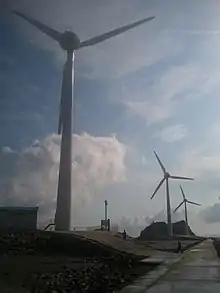Wind power in South Korea
Wind power in South Korea is a form of renewable energy in South Korea with the goal of reducing greenhouse gas (GHG) and particulate matter (PM) emissions caused by coal based power.[1] After two oil crises dating back to the 1970s, the South Korean government needed to transition to renewable energy, which encouraged their first renewable energy law in 1987.[2]
As of 2015 wind power capacity in South Korea was 835 MW and the wind energy share of total electricity consumption was far below 0,1%. In 2019, South Korea led an initiative in creating energy transition policies, which incorporated wind power along with de-fossil and de-nuclear in the Renewable Energy 2030 Plan.[1]
With wind power being the fastest growing power source in South Korea,[3] the Korean government's plan was to invest $8.2 billion into offshore wind farms in order to increase the total capacity to 2.5 GW until 2019.[4] In April 2020, the government announced the “Korean Green New Deal” which includes plans to drastically increase wind power through the expansion of domestic wind power facilities to include 8 MW offshore wind turbines by 2022 and floating offshore wind systems by 2025.[3]
Current uses

Most wind farms are in the province of Gangwon and Jeju Island because they have mountainous areas with high winds with speeds above 7.5 m/s.[5] Compared to these mountainous areas, the city of Seoul has a much lower wind speed, as its highest average wind speed is 2.85 m/s.[5]
Limitations
There are economic and use limitations that inhibit the widespread use of wind power.[5] The cost of wind energy is higher than conventional energy sources. Many wind farm owners are not satisfied with the service of large manufacturing companies like Vestas US for its high cost. [5] Vestas, a turbine manufacturer, holds a 42.2% market share in the Korean wind energy industry.[5] Shifting the reliance on large corporate manufacturers to local turbine manufacturers may help to reduce costs.[5] There are also costs to transmitting energy from offshore wind farms to destinations.[5] Since wind is not a consistent source of energy and can be affected by climate conditions, wind powered systems need to be accompanied by other energy sources to provide uninterrupted power supply. [5]
Current projects
The Singapore-based subsea engineering company, G8, received approval to build a 1.5GW offshore wind farm in late December 2021. The project is planned to be built off the south-west tip of South Korea with the build site having recorded wind speeds of 7-8 m/s. Current plans are to begin construction, as well as marine works in 2023 or 2024. The project also involves the use of an advanced, long-life lithium ion energy storage system from 3DOM, a technology partner of G8.[6]
Government policies
The South Korean government's Ministry of Trade, Industry and Energy promulgated “The 9th Basic Plan for Power Demand and Supply” (commonly known as the "Korean New Green Deal") in 2020, which includes plans to increase wind power from "1,834 MW in 2020 to 17,679 MW by 2030 and 24,874 MW by 2034."[3] Development has slowed in some areas due to resistance from local residents.[3][7]
Statistics
Installed wind power capacity in South Korea and generation in recent years is shown in the table below:[8]
| Year | 2004 | 2005 | 2006 | 2007 | 2008 | 2009 | 2010 | 2011 | 2012 | 2013 | 2014 | 2015 | 2016 | 2017 |
|---|---|---|---|---|---|---|---|---|---|---|---|---|---|---|
| Capacity (MW) | 65.7 | 183.6 | 190.0 | 192.7 | 298.0 | 333.3 | 366.7 | 418.7 | 491.5 | 583.4 | 644.7 | 852.5 | 1,034.6 | 1,143 |
| Generation (GW·h) | 47.4 | 129.8 | 238.9 | 375.6 | 436.0 | 685.3 | 816.9 | 862.8 | 912.7 | 1,148.1 | 1,145.5 | 1,342.4 | 1,683.1 | 2,169 |
See also
References
- Kim, Ju-Hee; Nam, Jungho; Yoo, Seung-Hoon (2020-10-01). "Public acceptance of a large-scale offshore wind power project in South Korea". Marine Policy. 120: 104141. doi:10.1016/j.marpol.2020.104141. ISSN 0308-597X.
- Baek, Seoin; Park, Eunil; Kim, Min-Gil; Kwon, Sang Jib; Kim, Ki Joon; Ohm, Jay Y.; del Pobil, Angel P. (2016-04-01). "Optimal renewable power generation systems for Busan metropolitan city in South Korea". Renewable Energy. 88: 517–525. doi:10.1016/j.renene.2015.11.058. ISSN 0960-1481.
- Lee, Kyung-Sook; Kim, Ju-Hee; Yoo, Seung-Hoon (2021-09-01). "Would people pay a price premium for electricity from domestic wind power facilities? The case of South Korea". Energy Policy. 156: 112455. doi:10.1016/j.enpol.2021.112455. ISSN 0301-4215.
- "Wind Energy and the Electricity Market in the Republic of Korea | Steve Richey". www.steverichey.com. Archived from the original on 2016-04-16.
- Alsharif, Mohammed H.; Kim, Jeong; Kim, Jin Hong (2018). "Opportunities and Challenges of Solar and Wind Energy in South Korea: A Review". Sustainability. 10 (6): 1822. doi:10.3390/su10061822. ISSN 2071-1050.
- Rajgor, Gail. "Plans approved for South Korean 1.5GW floating offshore wind and energy storage project". www.windpowermonthly.com. Retrieved 2022-04-22.
- Kim, Ju-Hee; Nam, Jungho; Yoo, Seung-Hoon (2020-10-01). "Public acceptance of a large-scale offshore wind power project in South Korea". Marine Policy. 120: 104141. doi:10.1016/j.marpol.2020.104141. ISSN 0308-597X.
- http://www.knrec.or.kr 2017년 신재생에너지 보급통계 책자(2018년판) pdf